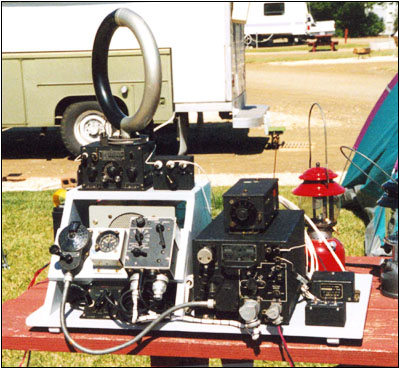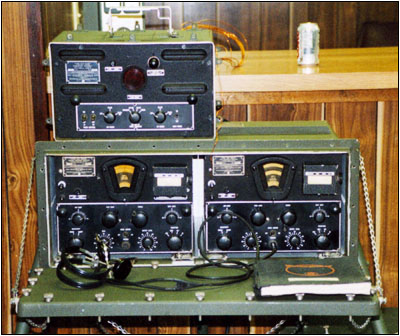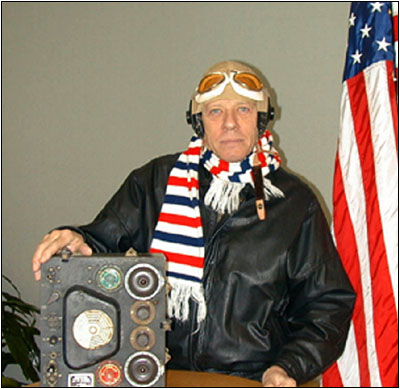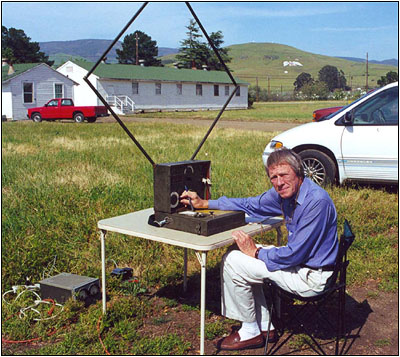Of Old Radios And Related Items--Published Monthly
Collecting Military Equipment--Part 4
Plus the Fifth International MRGC 2000 MeetBY HANK BROWN
Web Edition - More Photos & Info In Print Version
A.R.C. has been following the Military Radio Collectors Group (MRCG) annual meets for several years now, and each of Hank Brown's reports has attested to the growing interest in military equipment. Hank also includes much additional material on individual sets.
These articles help to open up a special category of radio history and its jargon and to introduce us to a highly participatory aspect of radio collecting. Past articles on this subject appeared in November '89, June '91, and November '94. Parts 1, 2 and 3 of this series appeared in March '99, August '99 and April '00. (Editor)
Weather conditions for the MRCG meet at Camp San Luis Obispo on May 4-6, Thursday to Saturday, were just about perfect for all three days. Although the meet was planned as a 2-day event, we really had an extra day by getting started Thursday afternoon.
Shortly after noon on Thursday, there already were five stations in the nearby camping area up and running on batteries, dynamotors, vibrator supplies, as well as 110V AC lines. Trucks, vans, campers, tents and other shelters were surrounded by masts with a variety of antennas and wires running up into the trees. Bands in use were 10-meter FM, 75-meter AM, 40-meter CW and hand-held rigs on 6-meter FM and 75-meter AM.
Later in the afternoon, the Noncommissioned Officers (NCO) Club began to take on the look of a military display area, as many transmitters, receivers, accessories and other items arrived for installation on tables. Some equipment was set up for display only, while other systems were fully operational with power supplies, mikes, keys, headphones or speakers. An operational display of two 1930s BC-148 Army trench radios was running on the high end of 75 meters using Morse code for local work. These early portable sets use a single tube in the transmitter and a 3-tube receiver. Many participants tried their hands at communicating with one another with the two units several hundred yards apart.
Jay Coward, KE6PPF, assembled this navigational system. A Navy Type ARB communications receiver is combined with a ZB-3 UHF navigation receiver on top. The UHF receiver converted navigation signals transmitted by an aircraft carrier down to the tuning range of the ARB receiver. Coded signals told the pilot which way to fly to return to the carrier. A DU-2 loop is on the left above control boxes and range filter. The loop was used for direction-finding work on lower frequencies.
An early U.S. Air Force AN/ARN-30 VHF navigation set was receiving bearings from the local VHF Omni Range (VOR) station on 112.4 MHz. The VOR navigation system for aircraft has been in operation for many years and is maintained by the Federal Aviation Administration. With VOR receiving equipment in an airplane a pilot is able to determine his bearing from a VOR station within a range of about 90 miles.
Mark Blair, KE6MYK, arrived in his big M998 HUMMWV military vehicle. The "Hummer" replaced the familiar little Jeep that was used for many years by all services. Mark had an AN/VRC-47 (Vehicle Radio Communications) radio installed in the vehicle. The radio is one of many types used by the Army for short-range work and operates on VHF bands with FM modulation.
A Navy semi-portable RBM-4 receiver set owned by Paul Thekan, N6FEG. Two storage batteries for primary power are below the carrying case/table. The set of 2 receivers weighs about 350 pounds and covers 200 kHz to 20 MHz. The top control unit allows operation of either receiver at one time or both receivers simultaneously.
Trish Gibbons, WA6UBE, joined the group with her 1954 Army M-37, 3/4-ton communications truck. The M-37 is probably best known as the "Dodge Weapons Carrier." This 4-wheel drive vehicle has been used for many different purposes, including cargo, ambulance and communications work. The Type S-144 shelter installed on the back of the truck was well equipped with late model digital tactical communications equipment on all bands. These late model surplus radios are often referred to as "green radios" because of their paint.
Off to the side a 1942 Ford GPW jeep with an AN/GRC-9 (Ground Radio Communications) and an RT-70 (Receiver/Transmitter, part of another GRC system) was used to move equipment from the campground area to the NCO club. Willys and Ford built most World War II Jeeps -- while the Ford unit is called the "GPW," the Willys is known as the "MB."
Another impressive installation was Dennis DuVall's red van with a 40-foot pneumatic mast on the back. An air compressor could be heard running from time to time to keep the mast up in the air. Rian Robinson, W6SVU, assisted Dennis in operating a large, high-power Type T-368 transmitter and R-392 receiver. The transmitter puts out about 400 watts, while the receiver is the military mobile version of the ever-popular R-390 radio. The antenna was a half-wave wire to nearby trees.
Meet activities were coordinated by the use of an Army PA system with an original Type T-17 carbon mike. A modern CD player provided great 1940s and 1950s music while the meet was underway. The PA system was a great deal of help in getting the word out as to what was happening and what was next on the schedule.
Friday Activities
On Friday, the NCO Club was opened early in the morning, and the meet was officially underway. Informal set up, field operations, and socializing took place most of the day. Many of the collectors were able to meet each other face-to-face after years of radio contacts, phone calls, e-mails and letter exchanges. More equipment arrived for display in the club.
Pizza, drinks and salad were served late Friday afternoon for about 50 people. The sign-in list indicates there were over 65 present for the day's activities.
The first of several DF (Direction Finding) exercises was conducted just after lunch. Cam Ogan, WA6VVC, provided a very small battery-operated transmitter with programmable voice message and variable RF power output The signal source is 51 MHz FM. A few trial runs were conducted so everyone could get a bit of experience with their antenna loops and portable rigs. Any type of equipment capable of receiving 51 MHz FM signals could be used to find the hidden transmitter. (See box on page 20 for more information on the hidden transmitter hunt.)
One DF'er did not have a loop, so he used his PRC-6 (Portable Radio Communications) with the antenna against his body for locating the little transmitter. His body acted like a shield for the antenna and provided directional indications. As he got closer, he folded the antenna up and took some more bearings by using his body as an RF shield. When really close, he removed the antenna and put a finger on the antenna post, which provided even more directional information. When just about on top of the transmitter, he used only the PRC-6 with no antenna as a probe to locate the culprit!
Bjorn Forsberg as the Red Baron with a British Royal Air Force (RAF) R.1082 receiver, ca. 1935, from the Swordfish airplane, which disabled the German Bismarck in 1944.
Andy Miller, KD6TKX, and Andy Becker, N0NVM, ran a DX (Distance) test with Navy MAB-to-MAB rigs on 3885 kHz. They worked about 3/4 of a mile apart on AM. The MAB is from the early part of World War II and operates from 2300 to 4500 kHz using AM modulation. Batteries and vibrator circuits provide power. Packaging is such that the portable units can be carried on an operators backs with suitable racks and straps. The antenna is a short flexible whip. The two operators had complete sets with all accessories as issued many years ago.
In a corner of the display room, a TG-7 teletype machine from 1943 (a military model of the commercial Model 15) with cover removed was clanking away at 60 wpm on local loop. This display provided a dynamic comparison between 1940s mechanical equipment operation and new solid-state gear that has no moving parts. Needless to say the noise from the machine attracted quite a few onlookers.
Saturday Activities
At 4:57 a.m. on Saturday, the scheduled swap meet activity started. The NCO club was opened, and a coffee pot plugged in to greet the early arrivals. The first light of dawn was still half an hour away as several flashlights pierced the darkened backs of trucks and vans to reveal military treasures. Muffled voices in the dark could be heard making deals, trades and sales. More trucks, vans and trailers arrived to fill the parking area. A large crowd pored over the various military items, which included transmitters, receivers, power supplies, manuals, parts and other accessories. Some of the rather rare items that were on display in the club found their way to tables in the swap meet to the delight of many buyers.
This busy period continued until about 9 a.m. when the formal program began in the club meeting room. Ludwell Sibley started the scheduled programs with an interesting series of slides and a spirited discussion of German and Japanese World War II equipment. Questions and comments from the group added to the program. Ludwell is the author of Tube Lore, a reference for users and collectors of vacuum tubes.
Bart Lee presented his continuing series on "Radio Intercept." For many years, Bart has been fascinated with radio eavesdropping, spying, decoding messages and gathering intelligence over radio circuits. He has been a regular participant and his long and detailed research was appreciated by all present. Bart is an active member of the California Historical Radio Society (CHRS) and the Antique Wireless Association (AWA).
The big noon BBQ was orchestrated by Dave Ragsdale with the able assistance of Quentyn Brown. The fire got a bit too high for a short while but a couple of cans of water took care of the problem. Just short of 100 servings were delivered during this popular part of the meet. The meal was excellent, and, as usual, there were no leftovers.
Cam Ogan and Mike Frey took the podium after lunch and presented a program on the late model "green radios." (These late, digital tactical radios are so called because of the paint used on equipment manufactured in more recent years. Earlier military radios were painted black or with the familiar olive drab paint scheme.) This area of collecting is becoming more popular, and many questions were raised and answered. Several working sets were available for a close look and hands-on experience.
Late in the afternoon Dennis DuVall made an announcement that a World War I flying ace with 19 kills would like to address the group. Although 9 of the kills were friendly and 10 were enemy, we decided to let the speaker proceed. Then, out walked Bjorn Forsberg in a World War I flying helmet with World War I French goggles, scarf and flying jacket. The spoof brought back memories of our first meet five years ago when Bjorn appeared dressed in a complete Russian submarine commanders uniform with medals from Russia, USA, England and France!
Bjorn discussed the RAF's (Royal Air Force) early 1930s regenerative receiver and accessories as used in the British Swordfish biplanes. The RAF R.1082 plug-in coil receiver works very well on all frequencies from 100 kHz to 22 MHz. One wonders how an operator changed bands while in the air since the set has 28 plug-in coils to cover all the bands. So far Bjorn has been a speaker at every MRCG meet, and we look forward to his sixth presentation next year.
A great daylong trip to the John Steinbeck home and museum in Salinas was the Saturday event of choice for several of the ladies. There they enjoyed a tour of the famous writer's house followed by lunch. Steinbeck, who was born in Salinas in 1902, published his Pulitzer Prize winning novel Grapes of Wrath in 1939. A visit to the Steinbeck museum took the group into the late afternoon.
The Bay Area Maritime Museum is another attraction in the San Francisco area that interests many meet participants. Bart Lee, Tom Horsfall, and Dick Dillman have been involved in developing this museum. If you're in the area, be sure to visit the complete victory ship radio installation ashore, as well as the S.S. Jeremiah O'Brien, a restored and operational Liberty Ship, and the U.S.S. Pampanito, a fleet submarine from the 1940s. Many hours of volunteer work were necessary to restore all of the radio equipment in these vessels to operational status.
In the Los Angeles area, there is also a restored and operational victory ship, the S.S. Lane Victory. Dennis DuVall is an active volunteer with this project.
Interested parties from the West Coast, midwestern, eastern and southeastern U. S. came to the meet. Ben Azari, G7RWR, of the Army Sales Company, joined us from London, England. Also from Europe was Trevor Sanderson, PA3BOH, who is with the Surplus Radio Society of Holland. Trevor reports they have about 200 members. He is also a member of the Vintage Military Amateur Radio Society (VMARS) in England. VMARS has about 150 members. We hope to see these gentlemen at the next meet.
One minute past 6 p.m. on Saturday, the final checks were made for forgotten equipment, the windows were locked and the NCO club was closed up for the last time. The fifth meeting of the MRCG was over with many tired but happy members heading for home. Several spent the night in the RV park area and got some more radio operating time in before heading home Sunday.
If you are interested in military radio collecting, watch our web site at "http://members.xoom.com/Milradio" for information, photos and comments. Mike Brown updates the site on a regular basis. There is even a Want/Sale page on the site. The MRCG theme is "Military Radio," which means any military communications device from any time period and from any place in the world.
Readers on the West Coast may want to listen to several of us on 3980 kHz AM about 9 p.m. local time on Saturday nights. Just about any shortwave radio tuning this frequency should provide satisfactory copy. Most stations are using older World War II radios. Discussions on this net are about military radio equipment, meet information, suggestions, plans for the next meet and other related topics.
MRCG does not collect dues but asks for contributions at the meets to reimburse volunteer's expenses for rent, mail, supplies and other incidental costs. E-mail contacts are: Hank Brown, htbrown@earthlink.net and Dennis DuVall, w7qho@aol.com. Dennis was selected to host the sixth MRCG international meet on the first weekend in May 2001, again at the Camp San Luis Obispo NCO Club. Hope to see you there.
Military Nomenclature
The "BC" in the military model number stands for "Basic Component," and the BC-148 is part of the SCR-131 system. The SCR stands for Signal Corps Radio and indicates that the equipment is a complete system.
Signal Corps, Navy and Air Force equipment designations were standardized towards the end of World War II so the "AN" indicates the Army-Navy designation system is used. The "ARN" stands for Airborne Radio Navigation type equipment. Another example of equipment designation is AN/ARC-5 in which the ARC stands for Airborne Radio Communications type equipment.
Army BC-148 Transceiver
Bjorn Forsberg is operating one of two BC-148 Army trench transceivers on the 75-meter band. The loop, a rigid design, is part of the single-tube, transmitter tank circuit and is used for both transmitting and receiving, not for direction finding. Power output is about 5 watts. The transmitter uses a single Type 10 tube. The receiver uses three Type 864 (VT24) tubes in a regenerative detector and 2-stage audio design powered by internal batteries.
Although back in the 1930s the Army advertised this radio's range as being in excess of 5 miles, these little transmitters were heard about 400 miles away during tests a few months before the meet,
At the meet, two stations were working each other on Morse code using BC-148s, but they were so close that a signal from the regenerative detector of the sending station was heard, as well as the transmitted signal.
Regenerative detectors are actually small transmitters since they can oscillate on the frequency they are tuned to receive. Therefore, if one BC-148 was tuned to receive on 3980 kHz, as well as tuned to transmit on 3980 kHz, the receiving station operator would hear the oscillating detector signal when the the key was up and the transmitter signal when the key was down. The key-up signal was loud and clear and almost as strong as the transmitter signal. Of course, this same problem existed when transmission was the other way around. Since operation was on one common frequency, this caused some confusion.
In earlier days, long-wave transmitters with arc or alternator designs could not be keyed by the usual on/off method so the frequency was shifted up and down by the keying circuits. For example, a transmitter may be assigned to transmit on 18 kHz with the key down; with the key up the circuit would be shifted to 22 kHz. The dots and dashes of a message could be heard on 18 kHz but other keying could be heard on 22 kHz. The signal on 22 kHz was referred to as a "back-wave."
In our case we solved the problem by running the transmitters and receivers in the BC-148s on slightly different frequencies.
Photo credits: Hank Brown, Bjorn Forsberg, Al Tipsword and Dennis DuVall
(Hank Brown, 4141 West L-2, Lancaster, CA 93536)
Hank Brown's interest in radio goes back to a childhood gift from his father of a Tom Swift book on adventures with wireless. Now retired from Hughes Aircraft, Hank's varied career includes working in broadcast stations and as a sailor on tankers and cargo ships, a stint in the Navy as a Second Radio Officer, and a hitch in the U.S. Army Signal Corps. He currently focuses on older tube-type radio gear.
| [Free Sample] [Books, etc., For Sale] [Subscribe to A.R.C./Renew] [Classified Ads] [Auction Prices] [Event Calendar] [Links] [Home] [Issue Archives] [Book Reviews] [Subscription Information] [A.R.C. FAQ] URL = http://www.antiqueradio.com/vinmilequip_Oct-00.html Copyright © 1996-2000 by John V. Terrey - For personal use only. Last revised: September 30, 2000. For Customer Assistance please contact ARC@antiqueradio.com or call (978) 371-0512 Pages designed/maintained by Wayward Fluffy Publications
Antique Radio Classified |



